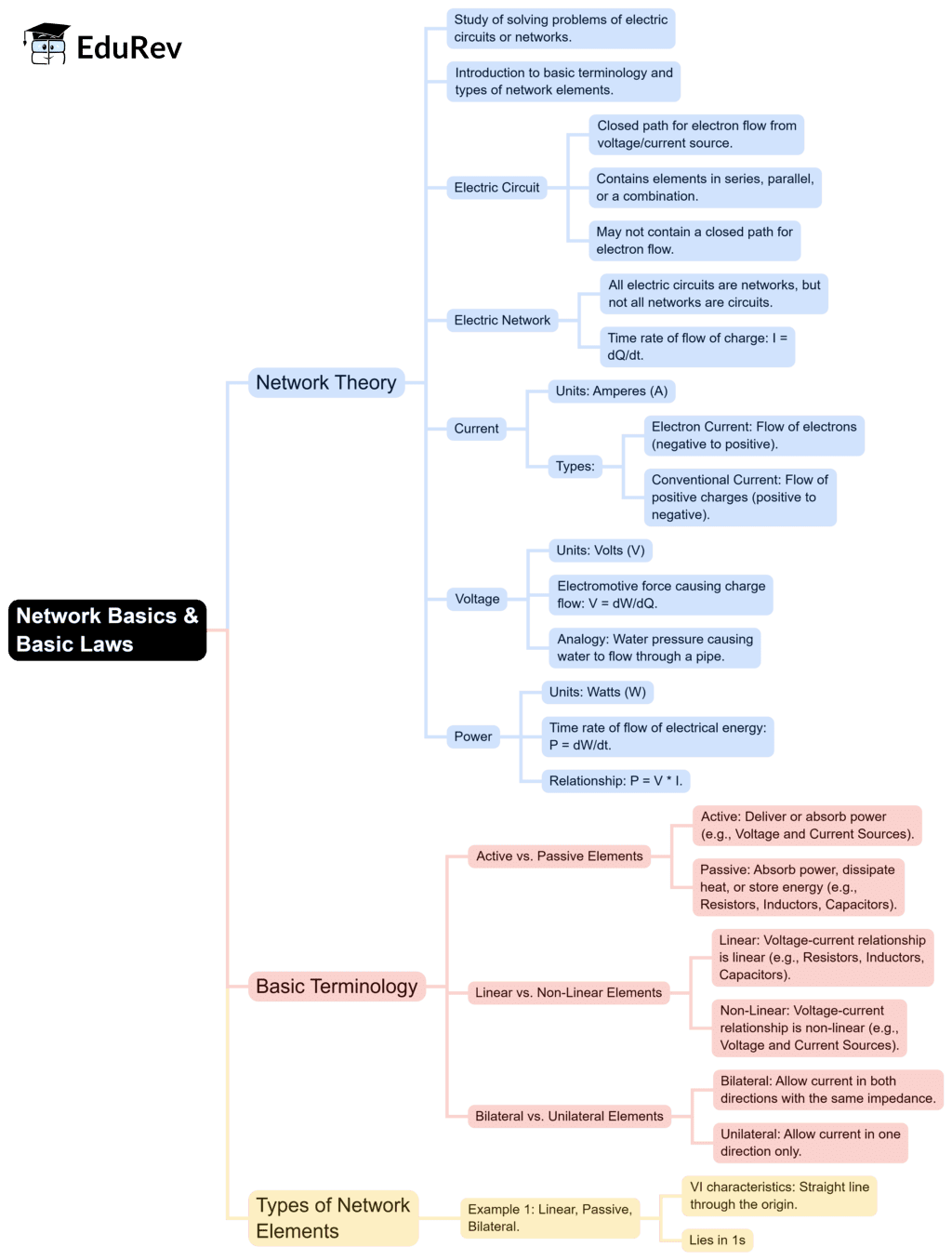Electrical Engineering (EE) Exam > Electrical Engineering (EE) Notes > Network Theory (Electric Circuits) > Mind Map: Network Basics & Basic Laws
Mind Map: Network Basics & Basic Laws | Network Theory (Electric Circuits) - Electrical Engineering (EE) PDF Download

The document Mind Map: Network Basics & Basic Laws | Network Theory (Electric Circuits) - Electrical Engineering (EE) is a part of the Electrical Engineering (EE) Course Network Theory (Electric Circuits).
All you need of Electrical Engineering (EE) at this link: Electrical Engineering (EE)
|
73 videos|139 docs|62 tests
|
FAQs on Mind Map: Network Basics & Basic Laws - Network Theory (Electric Circuits) - Electrical Engineering (EE)
| 1. What are the fundamental components of a computer network? |  |
Ans. The fundamental components of a computer network include the following:
1. <b>Nodes</b>: These are devices such as computers, printers, and servers that communicate over the network.
2. <b>Transmission Media</b>: This refers to the physical pathways (cables, fiber optics, wireless signals) that connect nodes.
3. <b>Network Interface Cards (NICs)</b>: These are hardware components that allow devices to connect to the network.
4. <b>Switches and Routers</b>: Switches connect devices within a single network, while routers connect different networks and direct data traffic.
5. <b>Protocols</b>: These are sets of rules that govern data communication over the network, such as TCP/IP.
| 2. What is the difference between LAN, WAN, and MAN? |  |
Ans. The differences between LAN, WAN, and MAN are as follows:
1. <b>LAN (Local Area Network)</b>: Covers a small geographic area, such as a single building or campus. It typically offers high-speed connectivity among connected devices.
2. <b>WAN (Wide Area Network)</b>: Covers a larger geographic area, often spanning cities, countries, or even continents. WANs connect multiple LANs and usually have lower speeds due to greater distances.
3. <b>MAN (Metropolitan Area Network)</b>: Falls between LAN and WAN, covering a city or a large campus. It is used to connect multiple LANs within a specific geographic area.
| 3. What are the basic laws of networking? |  |
Ans. The basic laws of networking include:
1. <b>Metcalfe's Law</b>: The value of a network is proportional to the square of the number of connected users.
2. <b>Reed's Law</b>: The value of a network increases exponentially as the number of groups formed by its users increases.
3. <b>Sarnoff's Law</b>: The value of a broadcast network is proportional to the number of users.
| 4. How does the OSI model facilitate network communication? |  |
Ans. The OSI (Open Systems Interconnection) model facilitates network communication by providing a framework that standardizes the functions of a networking system into seven layers:
1. <b>Physical Layer</b>: Deals with the physical connection and transmission of data.
2. <b>Data Link Layer</b>: Handles error detection and correction from the physical layer.
3. <b>Network Layer</b>: Manages data routing and forwarding.
4. <b>Transport Layer</b>: Ensures reliable data transfer with error correction.
5. <b>Session Layer</b>: Manages sessions and controls connections between devices.
6. <b>Presentation Layer</b>: Translates data formats and encryption.
7. <b>Application Layer</b>: Interfaces directly with end-user applications.
| 5. What is the role of IP addresses in networking? |  |
Ans. IP addresses serve several vital roles in networking:
1. <b>Identification</b>: Each device on a network is assigned a unique IP address, allowing it to be identified within that network.
2. <b>Location Addressing</b>: IP addresses provide information about the location of a device in the network, enabling data to be routed correctly.
3. <b>Communication</b>: They facilitate the communication between devices by allowing them to send and receive data packets over the internet or other networks.
Related Searches





















